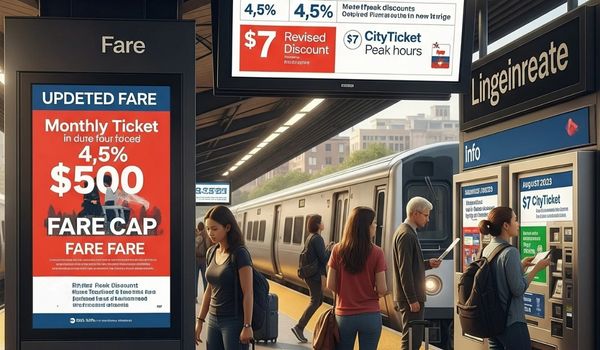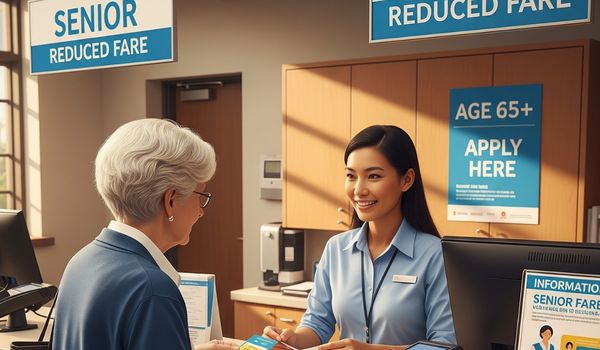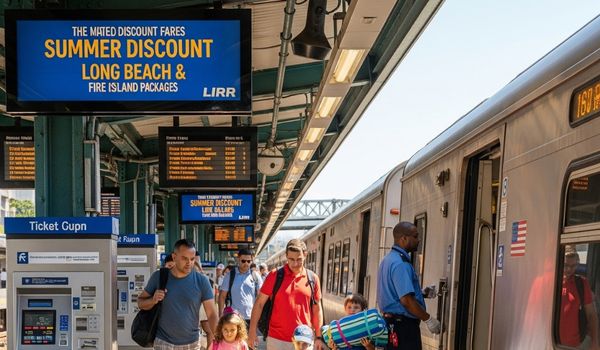The Long Island Rail Road (LIRR) provides a range of lirr fares options to suit different types of travelers. Riders can choose from one-way, round-trip, weekly, and monthly tickets, with discounted rates available for seniors, students, and people with disabilities. Monthly passes offer the best value for commuters traveling at least three times a week. For added flexibility, the 10-trip ticket is ideal for frequent travelers between Zone 1 and other zones.
Within New York City, the CityTicket offers a flat-rate fare—$5 during off-peak hours and $7 during peak hours—for travel that begins and ends within the city. Those transferring between the LIRR and Metro-North can use a Combo Ticket, which allows travel between the systems with an $8 add-on at Grand Central.
Tickets are available via the MTA TrainTime app, station machines, or onboard (with a possible surcharge). Fares are based on travel zones, and full details are available at the MTA website.
Long Island Rail Road Fares [LIRR Train Fares]
LIRR Monthly Ticket Fares
The Long Island Rail Road (LIRR) offers monthly tickets as a cost-effective option for frequent commuters. Here’s a detailed breakdown of how they work, their benefits, and factors influencing their fares:
| Zone | Zone Description | Current Monthly (2025) | Proposed 2026 Monthly | Increase Amount | Percentage Increase |
|---|---|---|---|---|---|
| 1 | City Terminal Zone (Manhattan) | $165.00 | $172.50 | $7.50 | 4.5% |
| 3 | Eastern Queens | $198.00 | $207.00 | $9.00 | 4.5% |
| 4 | Western Nassau County | $253.00 | $264.25 | $11.25 | 4.4% |
| 7 | Nassau County | $287.00 | $299.75 | $12.75 | 4.4% |
| 9 | Western Suffolk County | $341.00 | $356.50 | $15.50 | 4.5% |
| 10 | Mid-Suffolk County | $378.00 | $394.50 | $16.50 | 4.4% |
| 12 | Eastern Suffolk County | $433.00 | $452.00 | $19.00 | 4.4% |
| 14 | Far Eastern Suffolk County | $468.00 | $487.75 | $19.75 | 4.2% |
How LIRR Monthly Tickets Work
LIRR monthly tickets offer unlimited rides between selected zones for the full calendar month. They are non-transferable and valid only through the last day of the month, regardless of purchase date. Tickets go on sale from the 25th of the previous month through the 10th of the current one. While once issued on MetroCards, they’re now available as paper tickets or digitally via the TrainTime app.
Benefits of LIRR Monthly Tickets
- Cost Savings: For regular commuters (typically those traveling 3 or more days a week), a monthly ticket is the most cost-effective option compared to purchasing daily one-way or even 10-trip tickets.
- Convenience: Having a monthly pass eliminates the need to purchase a ticket for each ride, saving time and hassle.
- Unlimited Travel: The unlimited ride feature provides flexibility for spontaneous trips within your valid zones during the month.
How to Purchase LIRR Monthly Tickets
- MTA TrainTime App: This is the easiest and most recommended method, allowing you to plan trips, purchase tickets, and store them on your mobile device.
- Ticket Offices: Available at larger LIRR stations during operating hours. They accept cash, credit/debit cards, and some transit benefit cards.
- Ticket Machines: Located at most LIRR stations. Different types of machines (gray, red, blue) may offer different ticket types and payment options. Gray and blue machines typically sell all ticket types, including monthly passes.
- Mail&Ride Program: A subscription service that automatically delivers your monthly ticket (now to the TrainTime app) each month. This is particularly useful for those utilizing employer-sponsored commuter benefits.
LIRR Train Fare Increase
In August 2023, the MTA raised fares on the Long Island Rail Road (LIRR) as part of a systemwide fare adjustment to help cover rising operational expenses and maintain financial stability. This was the first fare hike since the pandemic and reflected the MTA’s return to its regular biennial fare review process.

Fare Changes
-
Monthly & Weekly Passes: LIRR monthly and weekly ticket prices rose by up to 4.5%. However, thanks to a 10% discount introduced in March 2022, monthly tickets remained more affordable than pre-COVID rates.
-
Fare Cap Introduced: To protect long-distance commuters, monthly fares were capped at $500, offering some relief for those traveling from outer zones.
-
Off-Peak Rates: Off-peak discounts were revised and unified at 26% for both LIRR and Metro-North riders, down slightly from the previous 27.5% LIRR discount.
-
CityTicket Expansion: CityTicket, which provides discounted LIRR fares within New York City, was extended to peak hours at a new rate of $7 (up from $5 for off-peak).
The fare changes took effect around August 20, 2023. The MTA stated the adjustments were necessary to sustain reliable service and improve infrastructure while minimizing the impact on riders through discounts, fare caps, and value programs.
LIRR Ticket Fare Zones
The Long Island Rail Road (LIRR) employs a fare zone system to determine ticket prices, with the cost increasing the further you travel from New York City. This distance-based pricing is common among commuter rail systems like the LIRR, Metro-North Railroad, and NJ Transit, in contrast to the flat-fare system of the NYC Subway.
How LIRR Fare Zones Work
The LIRR system is divided into a series of numbered zones, primarily radiating outward from Manhattan. The LIRR uses a zone-based fare system, where ticket prices depend on the distance traveled. Fares increase as you cross more zones, with Zone 1 covering central terminals in Manhattan, Brooklyn, and parts of Queens. Tickets are priced based on the zones of your origin and destination, not specific stations. For example, a Zone 1 to Zone 7 ticket is valid for any travel between those zones. As you move east through Nassau and Suffolk counties, zone numbers rise—from Zone 4 (western Nassau) to Zones 12 and 14 (eastern Suffolk, including the Hamptons and Montauk).
LIRR Seniors Fares
The Long Island Rail Road (LIRR) has concessionary rates for approved senior citizens. From this, a significant cut in the prices for regular fees can be obtained. The motive of the proposal is to bring public transportation closer and at lower costs for the elderly.
Eligibility for LIRR Senior Fares
LIRR fares for seniors get you the same half-price fare available on most tickets as riders age 65 or older experience convenient, comfortable travel along LI and in NYC. Riders who are disabled also qualify for the MTA Reduced-Fare program, with seniors able to commute and move around much more easily and inexpensively while attending offsite medical appointments, with no additional eligibility requirements for seniors.
How to Apply for the Discounted-Fares Program
The MTA has a Reduced-Fare program through which it has provided these discounted fares for seniors. This can be done through an in-person application or via snail mail. An online application is not being offered at this time.
1. Apply In Person:
Gather Documents: Bring along a valid photo ID that confirms age (65 and older). Acceptable IDs are those listed above.
Locations: You can apply at:
-
The Customer Service Centers found at some select subway stations (always open).
-
Customer Service Center at 3 Stone St., Lower Manhattan, weekdays.
-
Down to your neighborhood with the Mobile Sales vehicles.
Benefit: If you’re 65 or older: Applying in person is likely to get you a new Reduced-Fare OMNY card on that day.

2. Apply By Mail:
Download Application: For a downloadable version of the application for people 65 and older from the MTA website.
Fill Out Form: Fill out the application accurately.
Required Documents: Include:
-
One passport-size photo (2 inches by 1.5 inches).
-
a copy of a valid ID as proof of age.
Mail To:
MTA New York City Transit
Attn: Reduced-Fare Program
130 Livingston St.
Brooklyn, NY 11201-9625
MetroCard to OMNY Transition
The MTA is converting the current MetroCard reduced fares into OMNY. New customers who apply by mail might take longer to receive their Reduced-Fare OMNY cards (up to three months). Current holders of the Reduced-Fare MetroCard will eventually transition to OMNY.
Metro-North Senior Ticket Prices (65+)
Senior citizens 65 years or older are entitled to 50 percent off regular fare on Metro-North Railroad, except during peak hour periods.
| Zone | One-Way Peak Senior | One-Way Off-Peak Senior | Senior 10-Trip | Notes |
|---|---|---|---|---|
| 1 | Not eligible | $4.25 | $53.25 | Manhattan terminals |
| 2 | Not eligible | $5.75 | $72.50 | Bronx/Westchester border |
| 3 | Not eligible | $6.50 | $83.00 | Lower Westchester |
| 4 | Not eligible | $7.00 | $89.25 | Mid-Westchester |
| 5 | Not eligible | $8.00 | $100.00 | Upper Westchester |
| 6 | Not eligible | $9.25 | $115.00 | Putnam County |
| 7 | Not eligible | $10.25 | $127.50 | Northern suburbs |
Frequently Asked Questions
1. What is the present cost of monthly fares on the LIRR?
Monthly ticket prices reflect the number of fare zones traveled. For instance, a monthly pass from Zone 1 (e.g., Penn Station) to Zone 7 (e.g., Hicksville) costs around $287. With distance traveled, it will get costlier-this is true up to $468 for round trips between Zones 1 and 14.
2. How are LIRR fare zones decided?
The LIRR uses a zone-system; each station falls into a numbered zone. Ticket prices are then calculated through the origin and destination zones. The more zones you cross, the more you’ll pay.
3. Does the LIRR have weekend fare reductions?
Yes, on weekends a monthly pass holder can bring up to two guests for just $1 each way. There are no additional charges for the reduced fares available through the TrainTime app or onboard.
4. What qualifies as peak fare on the LIRR?
Trains entering NYC terminals on weekdays between 6:00 AM and 10:00 AM are peak fare trains. Hence, any traveling while this occurs will cost more than off-peak travel.
5. Have fares changed in LIRR at 2023?
Yes, as part of the systemwide adjustment in MTA, the fares at LIRR went up starting August 2023. Subway fares, for instance, raised prices to $2.90, and unlimited ride MetroCards also went up in terms of price.
6. How much does it cost from Ronkonkoma to Penn Station on the LIRR?
It depends on whether you are traveling at peak or off-peak. The fare from Ronkonkoma to Penn Station is $20.50 one-way during peak times and $15.00 one way during off-peak as of mid-2024.
7. Do the seniors get fare discounts on the LIRR?
As of now, the fare of all riders aged 65 and older qualifies for the discount, which is typically around 50 percent off the retail price. These tickets are not good on weekday morning peak trains headed west, and they require a valid ID or a Medicare card.
8. Where can you check LIRR schedules and fare details?
Complete schedules and fare information is available on the MTA website. You can even download each LIRR branch’s complete schedules in PDF or access them from the TrainTime app.
9. Where can I Buy LIRR Tickets at Station?
LIRR tickets are found at most stations using Ticket Vending Machines available for access 24/7. Manual Gray machines can accept cash, credit and debit institution cards to offer all kinds of tickets, but blue and red machines have limited options. Other than that, ticket offices are staffed at some stations. Purchasing a ticket onboard is possible with no surcharge if a station is not equipped with machines or ticket offices, but buying onboard when machines are available and a ticket office was opened comes with a surcharge.

